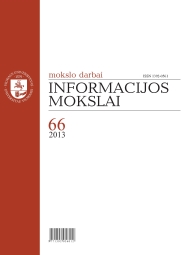Skirtingų Lietuvos auditorijos gyvenimo stiliaus grupių laisvalaikio medijų naudojimo ypatumai
CHARACTERISTICS OF LEISURE MEDIA USAGE IN DIFFERENT LIFESTYLE GROUPS OF THE LITHUANIAN AUDIENCE
Author(s): Daiva SiudikienėSubject(s): Media studies
Published by: Vilniaus Universiteto Leidykla
Summary/Abstract: Processes of the media digitization and convergence generate new practices of media usage and new patterns of audience activity and selectivity. Media audiences perform their choices of media when, where, and what to use in the multimedia environment, which is characterized by a completely differrent nature and logic of operation than the traditional media. The article has been prepared on the basis of a qualitative research. The aim of this article is to reveal the characteristics of leisure media usage in different lifestyle groups of the Lithuanian audience. The applied approach of the media repertoire is suitable for investigating the specifics of media usage in the multimedia environment. Analysis of the data has revealed that media users combine their own individual repertoires selecting only some of the available choices. The findings show that, despite the growth of media and content resources in the living environment of the individuals, respondents regularly use only part of them, selecting and combining those best suited to the rhythm of their lives, daily habits, and needs. Various lifestyle groups have differently designed their media repertoires in the multimedia environment. Schemes of the use of the media are closely related to the rhythm of an individual’s everyday life, when in each phase of the day users select different media related to the functions they perform, and different media used to satisfy different needs. Each medium performs a particular function in an individual’s life, depending on his needs, lifestyle, mobility, the media that are used by his peers and friends, employment, and the necessity of continuing professional activity after working hours. The number of combined media is determined by the level of media literacy (ability to use digital and mobile technologies and an understanding of their facilities), the variety of needs and aims (a greater number of needs and aims has an influence on a longer time span of using the media), predominant habits of the use of media (respondents explained media selections, for example, reading paper magazines, by habitude), recommendations from influence groups. Selections of media content encompass both rational and irrational reasons; nevertheless, making decisions on the selectable content is based on the corresponding strategy of personal behaviour, which takes the identification of topics as an important aspect. Among all available alternatives, media users look for attributes of the dominant topics they are familiar with and which are related to their interests, recommendations, pre- existing experience or the established criteria of merit and expedience.
Journal: Informacijos mokslai
- Issue Year: 2013
- Issue No: 66
- Page Range: 34-55
- Page Count: 22
- Language: Lithuanian

